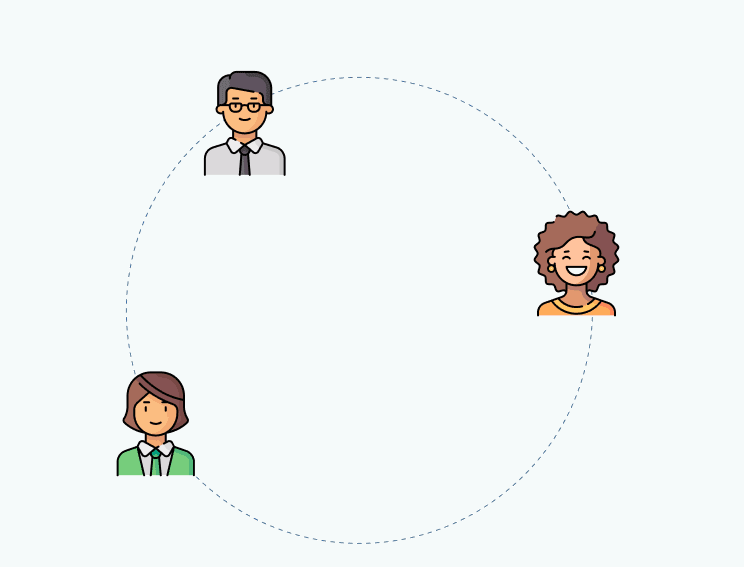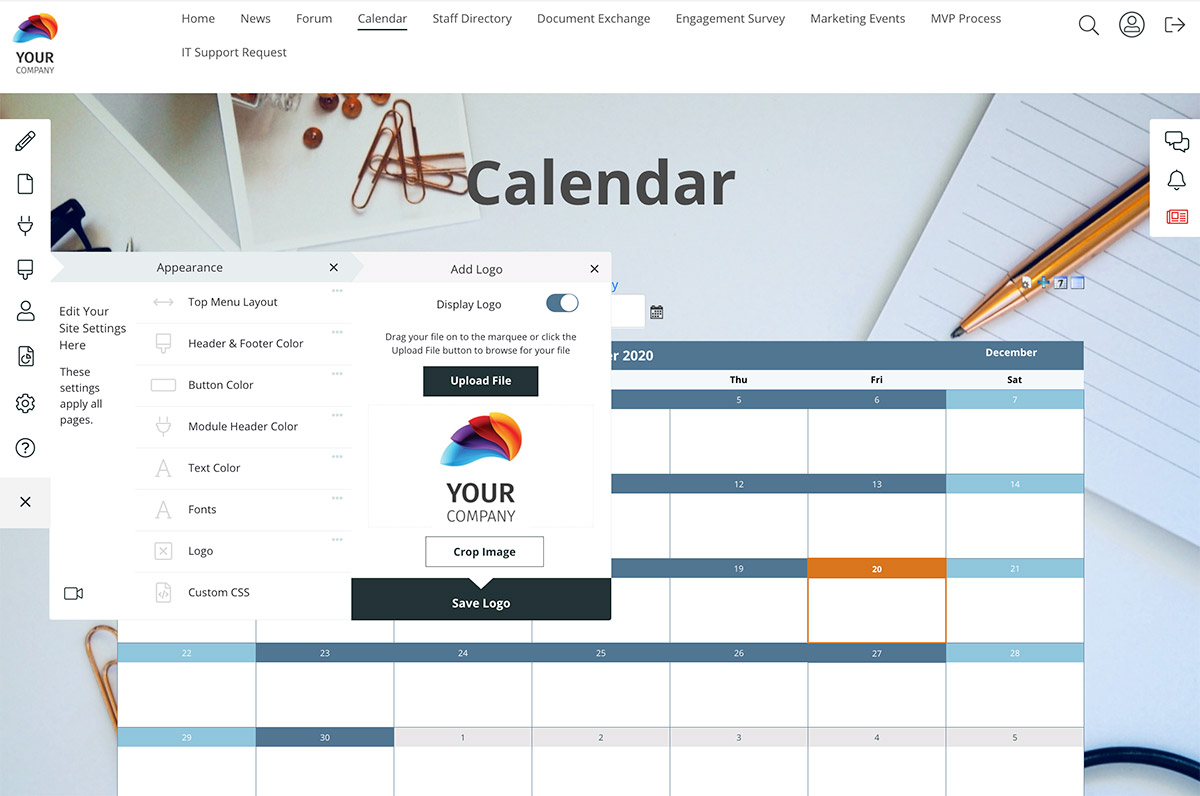
Your New Intranet Starts Here
Streamline communication, boost collaboration, and empower your team with MyHub's intuitive intranet solution.
Book a live demo now and experience the difference.
Take a Quick TourWhen it comes to intranet services, what’s the best option? Should you do it yourself or hire an intranet developer? If you have been charged with delivering your organization’s intranet, then no doubt you have been grappling with this question.
In this post, we will help you identify the answer that’s right for your business needs and circumstances.
Every project has to work within different constraints that shape the way it is delivered. One of the best ways to model these constraints is the project management triangle, also known as the iron triangle.
So, let’s look at each point of the triangle and consider whether it’s best to do it yourself or hire an expert for your intranet deployment.
Time Is Precious
In every business, time is a precious commodity. The amount of time available is likely to be a significant constraint on your intranet deployment project. With that in mind, we recommend the most important first step is to define clear project objectives. A well-defined purpose and direction will save you valuable time throughout the development process.
For most businesses, the driving force behind implementing an intranet is to resolve a specific pain point. This could be improving internal communications, enhancing knowledge management, increasing employee engagement, or creating better collaboration opportunities.
Often, the intranet is introduced to support a key business-driven outcome, such as reducing communication costs or streamlining processes ahead of a new product launch. Your intranet’s purpose will heavily influence your project’s timeframe. Some goals are urgent and require rapid deployment, while others allow for a more gradual rollout. How much time you have will also affect your decision to do it yourself or hire an expert. Developing an intranet from scratch is time-consuming, especially if you lack an internal IT resource.
Even if you opt for open-source platforms like WordPress for a DIY intranet, it remains a labor-intensive process. WordPress and SharePoint, for instance, were not originally designed for intranet creation, making technical know-how essential to navigate plugins and add-ons.
Hosting an intranet onsite also demands time and resources. Maintaining servers consumes physical space and valuable staff time, which might be better allocated elsewhere.
If your internal IT team is fully booked for months, the pain point the intranet was meant to fix will persist. In such cases, hiring an external intranet developer can accelerate deployment and help you start reaping benefits sooner. For example, if a product launch is scheduled in three months, engaging an intranet developer ensures your platform supports the launch on time. However, if your timeline is flexible and you have internal expertise, a DIY intranet might be a viable and cost-effective solution, especially if customization is a priority.
People And Resources
Successful intranet deployment requires having the right people and resources in place. Do you have an in-house intranet expert? If yes, the do-it-yourself approach could work well. For many small businesses, however, this expertise is lacking. You wouldn’t attempt to rewire workplace electrics without an electrician. Similarly, it makes sense to hire a skilled intranet developer to guide your project from start to finish. An intranet developer brings extensive experience in designing, implementing, and troubleshooting intranet solutions, along with specialist knowledge of features and functionality.
Many underestimate the time investment for a DIY intranet. Setting up from scratch can take several months, even when using off-the-shelf platforms like WordPress. DIY also means you are responsible for thorough testing before going live. This includes assessing usability, navigation, search functions, and ensuring the intranet meets employee needs. In our experience, a meaningful pilot phase lasts at least six weeks, allowing time for feedback and necessary adjustments. Costs for a DIY intranet can escalate quickly, including time spent by employees on implementation, server hosting expenses, and ongoing maintenance.
Hiring an intranet developer often provides a more efficient use of resources. Experienced developers know how to avoid common pitfalls and tailor solutions to your business needs.
Most developers offer cloud-hosted solutions, eliminating the need to purchase or maintain company servers, while also handling security, backups, and updates. Security is a critical concern. With a DIY intranet, you must manage encryption, firewalls, and antivirus protection yourself. An intranet developer takes on these responsibilities, ensuring your platform stays secure with the latest features. Developers typically provide pre-built and pre-tested intranet design templates that come with coding and basic design, allowing you to customize easily with drag-and-drop tools.
Popular intranet templates include:
- Newsfeeds and blogs – keep employees updated with critical company and team news.
- Staff directory – connect employees with engaging profiles and facilitate collaboration.
- Automated forms – streamline business processes and approvals digitally.
- Secure file and document storage – enable easy document exchange and collaborative editing.
- Team chat – foster instant communication, speed decision-making, and boost company culture.
- Forums and project spaces – private collaboration zones for teams to share information, solve problems, and track progress.
- Social intranet features – @mentions, activity walls, and updates sharing among staff.
- Quizzes and surveys – collect employee feedback on important topics to inform decision-making.
Simply choose the functionality your business requires, then customize templates with your branding, logos, content, and images.
Though many clients use the same base templates, customization ensures each intranet is unique and tailored to specific organizational needs.
Additionally, you can access testimonials from other companies with similar needs, ensuring your intranet solution performs effectively.
The bottom line: working with an intranet developer provides economies of scale and smoother, hassle-free implementation since much of the hard work is already done.
Word of caution: avoid using general website developers for intranet projects. While they excel at websites and apps, they often lack the specialized knowledge required for successful intranet solutions and may not fully understand your organizational challenges.
Intranet Services And Value For Money
Making sure your intranet offers value for money is a crucial constraint impacting your intranet project. Undoubtedly, there will be significant organizational pressure to ensure the intranet delivers a strong return on investment (ROI).
If you choose the do-it-yourself (DIY) route, it’s vital to thoroughly consider all potential costs involved. These expenses extend far beyond just the software itself. Many hidden costs may not be immediately apparent, including:
- Employee training and development programs to effectively upskill staff on the new platform
- Costs of add-ons and plugins necessary to provide the full functionality you require
- Development and thorough testing of the pilot intranet before full deployment
- Purchasing, hosting, and ongoing maintenance of additional company servers
In contrast, opting for an intranet developer combined with a cloud-hosted solution offers greater cost certainty. Clear terms of engagement outline the roles, responsibilities, and fees involved. Cloud hosting typically proves very cost-effective, with fixed monthly fees, unlimited user licenses, and scalable data storage. For small businesses especially, this cost predictability is a significant advantage.
No One-Size Solution
For many organizations, engaging an intranet expert to deliver a comprehensive solution is an efficient use of resources. It saves valuable time and provides greater cost certainty, making it easier to stay within budget and meet deadlines.
Pre-built intranet design templates have become incredibly user-friendly. For many businesses, these templates offer an ideal, ready-made solution that can be customized quickly and effectively.
At MyHub, our customers often customize our design templates to build a bespoke intranet tailored to their needs. Typically, it takes just a few days to get such an intranet up and running.
Conversely, a DIY intranet can require several months of lead time and is often labor-intensive. A significant number of employees may be diverted from critical tasks during development and rollout. Moreover, the services of a professional intranet developer are competitively priced, making them an excellent choice for time-constrained businesses seeking rapid deployment to solve urgent organizational challenges. For companies with the will, resources, skilled personnel, and sufficient time, a fully bespoke intranet can be a rewarding choice.
However, if you want a fast, easy-to-implement intranet solution, get in touch with us at MyHub. Let us take the stress and hassle out of your intranet implementation. We are the number one choice for hundreds of businesses of all sizes across diverse markets worldwide. Discover why by booking a free intranet demo or signing up for a no-obligation 14-day trial. Contact us today and start your intranet journey.
How An Intranet Works
Before diving deeper, let’s revisit the basics of how an intranet works.
An intranet is an internal website accessible only to employees. Like the internet, it uses the transmission control protocol/internet protocol (TCP/IP) communications standard to connect hosts and users over a local area network (LAN). Remote employees can securely log in using a VPN or IP whitelisting, making intranets ideal for hybrid workplaces and on-the-go staff.
Intranets are built using programming languages such as HTML, Java, or XML to create web pages with text, images, video, and audio content. These pages are displayed to users similarly to internet websites.
Some organizations extend limited intranet access to clients or partners outside the LAN. These setups are called extranets, common for collaboration with graphic designers, accountants, or legal teams.
Another variation is the portal, a gateway that allows access to external enterprise systems like CRM platforms (e.g., Salesforce) or HR management systems. Portals enable seamless integration, letting employees access essential enterprise applications directly from the intranet.
Intranets are highly flexible platforms addressing a wide range of business functions, ultimately improving productivity and efficiency. Key benefits include:
- Improved internal communications
- Knowledge management
- Enhanced team collaboration
- Streamlined business processes
- Boosted employee engagement
- Support for hybrid working models
With such comprehensive benefits, it’s no surprise intranets are the preferred choice for digital workplaces worldwide.
Custom-Built Intranet Development
When it comes to developing a bespoke intranet, the typical process for a web development agency involves several key steps. These include the following:
Requirements Gathering
The first step is gathering detailed information on the client’s requirements and conducting a thorough needs analysis. This stage involves answering crucial questions such as:
- What does the client want their intranet to achieve?
- What key features and business tools are relevant?
- What are the baseline requirements for data and information?
Often, the driving force behind an intranet project is a specific business pain point or operational issue that needs resolution. This might include:
- Poor internal communications
- A need for faster and more accessible information and data sharing
- A desire to boost productivity through streamlined processes
- Challenges related to departmental information silos
This phase may involve conducting focus groups, staff surveys, or workshops, which require significant time and engagement to complete effectively.
Information Architecture
The next step is to create the information architecture for the intranet. This means identifying the site’s main topics and subtopics, mapping out business processes, and developing detailed information and data flow diagrams. It also includes creating an initial sitemap, thumbnails, outlines, and a table of contents to guide the build.
Design
Designing the intranet’s overall look and feel is a collaborative effort. The client typically has specific preferences regarding the site design. This stage requires a significant investment of time to finalize:
- Page grid and layout
- Graphic elements and overall aesthetic
- Interface design, illustrations, and photography
Development
Developing a functional prototype is critical. This allows the client to experience the platform’s navigation and content delivery firsthand. From the developer’s perspective, it ensures the platform aligns with organizational goals and is fit for purpose. It also provides an opportunity to refine the user interface.
Testing
The final and essential phase is rigorous testing. The intranet software must be extensively evaluated for:
- Functionality
- Code quality
- Speed and performance
- Ease of use
- Ongoing management capability
- Reliability and stability
- Compatibility across platforms
- Mobile optimization
- Overall user appeal
Testing also involves confirming that the platform meets the needs of end users in terms of usability and design. Ideally, individuals not directly involved in development, such as internal colleagues or a representative sample of users, conduct the testing. They report issues such as bugs, broken links, form errors, and offer feedback on design effectiveness.
As evident, bespoke intranet development is a time-consuming and labor-intensive process requiring significant investment from both the agency and client. Furthermore, there is inherent risk, as even a comprehensive process does not guarantee that the client will proceed.
Hosted CMS Solutions
Cloud-hosted intranets offer many extra welcome benefits for your customers. Instead of purchasing additional servers, hosting, and maintaining their intranet in-house, the entire system is outsourced to a professional hosting company. The key benefits include:
- Up-to-date security features ensuring your data is protected
- Fixed monthly costs for predictable budgeting
- Unlimited users allowing scalability as your business grows
- Automatic updates and backups for peace of mind and minimal maintenance
CMS intranets eliminate the uncertainties commonly associated with bespoke intranet versions. They deliver customers a better return on investment while significantly reducing risk for the developer.
From a consultant’s perspective, this means you can focus more on understanding and delivering against the customer’s unique requirements. Positioning your agency as highly responsive and capable of rapid delivery provides a competitive advantage. Unlike other agencies that may prioritize maximizing billable hours, you can emphasize fast, effective solutions.
Thanks to the intuitive and easy-to-follow setup and streamlined ongoing management of CMS templates, intranet deployment is accelerated. Clients can get started quickly and begin to realize benefits in days rather than weeks or months.
Partner With MyHub Intranet Solutions
Meet your needs and those of your customers by partnering with MyHub. Consistently rated highly on independent review sites, we offer much more than just intranet software. We streamline the intranet development process and ensure end-user activities are better aligned. Our platforms are trusted by intranet development businesses and diverse organizations worldwide. Here are just some of the reasons why MyHub stands out.
1. Experience
With over 20 years of experience, we bring an unmatched wealth of expertise. Our track record includes everything from very simple to highly complex, fully customized intranet platforms.
2. Readily Accessible Support
Not all suppliers provide equal support. At MyHub, we work alongside you at every stage, from design and prototype development to launch and beyond. Our team offers long-term maintenance support to ensure your success.
We provide an extensive online library filled with resources and explainer videos, plus knowledgeable technicians ready to assist you with any technical challenges. Help is always on hand with MyHub.
3. Dedicated Design Service
From frontend to backend development, MyHub’s dedicated design service delivers a fully functioning intranet site rapidly. Many off-the-shelf options require clients to set up and configure platforms themselves, causing delays and frustration.
MyHub removes this complexity and risk by handling the entire process. Our expert designers create a customized, fully operational intranet in 40 days or less , guaranteed.
The design process is broken down into three simple stages:
- Scope and commercials: Gathering requirements, defining objectives and timelines, agreeing on the scope, and developing a sitemap.
- Site design: Customizing branding, colors, logos, designing pages, adding graphics and content, creating document exchanges, setting user permissions.
- Launch: Going live, handover, training, and post-launch support included.
Our comprehensive design solution means your clients benefit from speed, responsiveness, and expert guidance every step of the way.
4. Value-Added Services
At MyHub, we provide a wide range of value-added services, including expert advice on content migration from other systems. We also offer free site audits, intranet optimization, and ongoing post-launch support to maximize your platform’s performance.
5. Security Guaranteed
Security of valuable company data is a top priority. We understand the complexity involved in protecting against both external threats, such as malware, and internal risks like unauthorized access.
MyHub’s platform includes industry-leading security measures: firewalls, two-way SSL encryption, and hosting via Amazon Web Services (AWS) that comply with standards such as SOC 2. This robust infrastructure takes a huge security burden off your shoulders.
Internal security controls are also maximized, including automated password resets, granular page and user permissions, and IP-based access restrictions. In short, you and your customers can trust that security is comprehensively covered.
SharePoint Intranets vs. MyHub
Some intranet developers view SharePoint as a middle ground between bespoke and off-the-shelf solutions. It is free to download and integrates well with Microsoft Office 365, which appeals to many customers. It comes with a core offering and supports additional plugins to enhance functionality.
However, SharePoint has notable limitations. It can be clunky to set up and use, especially for businesses lacking internal tech expertise. The core platform often requires multiple add-ons to meet business needs, which can quickly increase costs. Upgrading the software becomes the client’s responsibility, creating a confusing and time-consuming maintenance challenge.
Customization options are limited, and standalone SharePoint intranets tend to retain a generic Microsoft look and feel.
In contrast, MyHub offers a comprehensive, pre-built set of customizable intranet tools that are ready to deploy rapidly. Our templates ensure a platform unique to each client, with scalable growth as the business expands. MyHub also includes the latest industry-standard security and provides expert design support at every stage, making implementation smoother and less risky.
Agency Intranet Development Final Thoughts
Intranet development services from a digital agency empower businesses to digitalize their internal processes and transform operations. With digital transformation statistics showing that only 8% of companies have digital operations across all departments, digital agencies hold a vital role in helping organizations embrace change.
An intranet development agency offers complete solutions that leverage the latest technology and proven methodologies to maximize efficiency and streamline internal communication. By analyzing specific organizational needs, agencies can recommend tailored adaptations and implement customized intranet solutions that drive success.
Looking for an intranet solution that meets the needs of both your customers and your web development agency? Sign up today for MyHub’s free demonstration or no-obligation 14-day trial period and discover how our software simplifies and accelerates intranet development.
FAQ Section
What is intranet development?
Intranet development refers to the design, build, and deployment of internal digital platforms that connect employees, house content, integrate tools, and streamline collaboration.
Why choose a cloud-hosted intranet over on-premise solutions?
Cloud-hosted intranets offer automatic updates, robust security, built-in scalability, and predictable monthly costs—without the infrastructure headaches and maintenance overhead of on-prem systems.
How does MyHub differ from SharePoint?
Unlike SharePoint, which often relies on added plugins and custom coding, MyHub presents a ready-to-use, template-driven intranet with security, support, and tailored branding included—simplifying deployment and boosting ROI.






